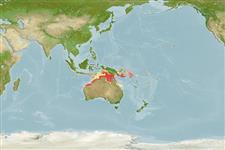Élasmobranches (requins et raies) (sharks and rays) >
Myliobatiformes (Stingrays) >
Dasyatidae (Stingrays) > Neotrygoninae
Eponymy: Guy Geoffrey Leyland (d: 1950) is Principal Executive Officer, Western Australia Fishing Industry Council. [...] (Ref. 128868), visit book page.
More on author: Last.
Environment: milieu / climate zone / depth range / distribution range
Écologie
marin démersal; profondeur 5 - 80 m (Ref. 9840). Deep-water; 4°S - 21°S
Western Pacific: northern Australia and New Guinea, including the Arafura Sea and Timor Sea.
Taille / Poids / Âge
Maturity: Lm ? range ? - ? cm
Max length : 25.0 cm WD mâle / non sexé; (Ref. 6871)
Found on the continental shelf (Ref. 6871, 75154). Size at birth about 11 cm WD (Ref. 6871). Exists as two color forms. Ovoviviparous (Ref. 50449).
Life cycle and mating behavior
Maturité | Reproduction | Frai | Œufs | Fécondité | Larves
Exhibit ovoviparity (aplacental viviparity), with embryos feeding initially on yolk, then receiving additional nourishment from the mother by indirect absorption of uterine fluid enriched with mucus, fat or protein through specialised structures (Ref. 50449). Distinct pairing with embrace (Ref. 205).
Last, P.R. and J.D. Stevens, 1994. Sharks and rays of Australia. CSIRO, Australia. 513 p. (Ref. 6871)
Statut dans la liste rouge de l'IUCN (Ref. 130435: Version 2024-2)
Menace pour l'homme
Harmless
Utilisations par l'homme
Pêcheries: sans intérêt
Outils
Articles particuliers
Télécharger en XML
Sources Internet
Estimates based on models
Preferred temperature (Ref.
123201): 26.2 - 28.6, mean 27.7 °C (based on 312 cells).
Phylogenetic diversity index (Ref.
82804): PD
50 = 0.5039 [Uniqueness, from 0.5 = low to 2.0 = high].
Bayesian length-weight: a=0.01096 (0.00350 - 0.03435), b=3.12 (2.87 - 3.37), in cm total length, based on LWR estimates for this (Sub)family-body shape (Ref.
93245).
Niveau trophique (Ref.
69278): 3.4 ±0.3 se; based on size and trophs of closest relatives
Résilience (Ref.
120179): Faible, temps minimum de doublement de population : 4,5 à 14 années (Assuming fecundity<100).
Fishing Vulnerability (Ref.
59153): Moderate vulnerability (40 of 100).
